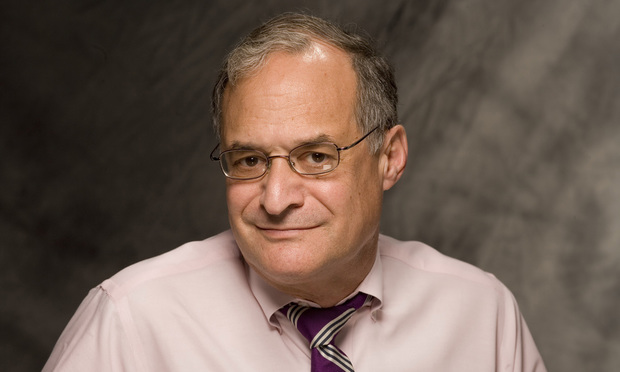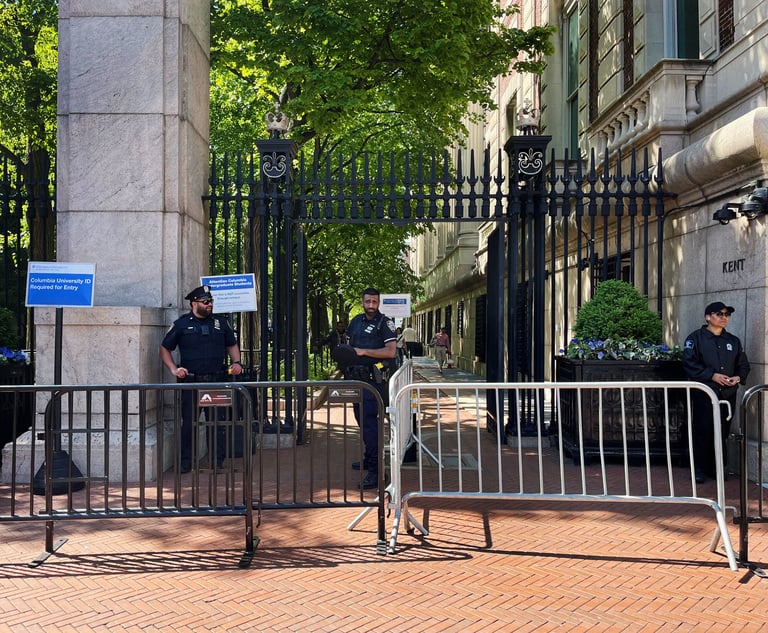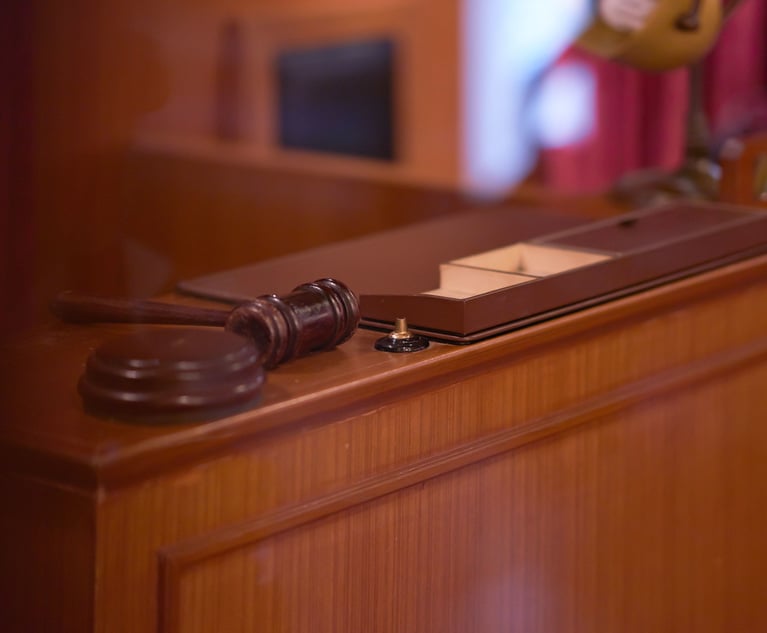Ahead of the Curve: Dispatches from the Association of American Law Schools' Annual Meeting
Legal educators rolled out the red carpet for U.S. Supreme Court Justice Ruth Bader Ginburg, and they couldn't stop talking about U.S. News & World Report's new scholarly impact ranking.
January 06, 2020 at 09:00 PM
9 minute read
Welcome back to Ahead of the Curve. I'm Karen Sloan, legal education editor at Law.com, and I'll be your host for this weekly look at innovation and notable developments in legal education.
I'm just back from three days at the Association of American Law School's annual meeting in Washington, still mulling the many interesting discussions and panels I saw. I'm sure I'll have more to say about those, but for today I'm highlighting a few key events and topics that arose in D.C. First is the visit by U.S. Supreme Court Justice Ruth Bader Ginsburg and the reception she received, which was more enthusiastic than any I've seen in nearly a decade of attending this meeting. Next I'm wading through the many panels and discussions centered on law school rankings, and more specifically, the introduction of U.S. News & World Report's scholarly impact ranking.
Please share your thoughts and feedback with me at [email protected] or on Twitter: @KarenSloanNLJ

The Notorious RBG Brings the House Down
Before I jump in to what was clearly the highlight of the AALS Annual Meeting—Ruth Bader Ginsburg's visit—I want to share a quick observation about the atmosphere of this year's conference, which took place over four days in Washington and drew about 2,400 people.
All in all, it was a pretty upbeat event. Not a single program focused on, essentially, how to keep your law school afloat in tough times. The law school-hosted cocktail receptions were plentiful, and people seemed overall optimistic about legal education's present and future. (That echoes the sentiments of newly installed AALS President Darby Dickerson, who told me earlier that law schools are at their strongest point of the past decade, which, to be fair, is a pretty low bar to clear.) Some of the programming focused on tough issues, such as how to help financially challenged students and the myriad hurdles women of color face in the academy, but for the most part people seemed not just hopeful but confident that the worst was behind legal education.
Now on to Ginsburg. If you want to get more detail on the justice's Jan. 4 remarks, you can read my story here. For the record, she didn't say anything particularly newsworthy and mainly told stories that are familiar to most RBG fans. But what really stood out to me was the reaction the justice received from the professor crowd, which was unlike anything I've ever seen in nearly a decade of attending the conference. I've seen several Supreme Court justices make the AALS rounds, including RBG's 2015 visit, but the sheer excitement and anticipation of her talk on Saturday was in another league. The line to get in formed early and eventually snaked around the lobby of the Marriott Wardman Park. The crowd was, dare I say it, giddy to see the justice and didn't seem too annoyed that her arrival 30 minutes late might jeopardize their dinner reservations. More than a few people brought their kids. I talked to several as I waited in my seat (45 minutes!) and they assured me that they had actually wanted to come and weren't dragged against their will by their parents.
Ginsburg has clearly risen above her Supreme Court colleagues in terms of her status in the public conscience and in pop culture to become an icon of women's rights. Will there be a documentary and feature film about Samuel Alito? Unlikely. But pretty much all of the professors that I chatted with at the event said they felt like this was a special moment in time for the justice and that they didn't want to miss out on what may likely be their last chance to see her in person. (Ginsburg is 86 and is undergoing treatment for her fourth bout with cancer, though she told the audience she is on the road to recovery.)
Saturday's event felt like something of a victory lap and a return to her roots for Ginsburg, who began her legal career as a professor at Rutgers Law School. No law firm would hire her in the 1960s because she's a women. She talked about the work she did with the AALS as a law professor to end sexism in the legal academy. It didn't matter that her anecdotes were well-worn. The adoring crowd hung on her every word and left satisfied and inspired by her tale of ascending to the peak of the profession. Will she be back at the AALS someday? My gut says no, and I too am happy I took the opportunity to hear her share her story.

Rankings, Rankings, and More Rankings
In case that headline didn't tip you off, rankings were a big deal at this year's annual meeting. More specifically, U.S. News & World Report's introduction of a "scholarly impact" ranking of faculties appears to have more than a few people in a tizzy. That ranking was a focus of no less than three separate panels over the weekend, two of which featured Bob Morse, U.S. News' chief data strategist and the person responsible for the law school rankings. Legal academics love to hate on Morse and the U.S. News rankings, primarily for what they see as the outsized influence of the rankings on prospective students and the pernicious effects of playing the rankings game. So Morse is used to facing the slings and arrows of law professors, and frankly, he got away from this year's AALS relatively unscathed.
Anyway, U.S. News announced a year ago that it would partner with legal publication publisher HeinOnline to produce a new "scholarly impact" ranking of law schools based on faculty citations in law reviews, which would be separate from the overall rankings, at least initially. Given that the existing specialty rankings don't get much attention, I was surprised to see the level of anxiety surrounding the new scholarly impact ranking. Morse basically told me the same thing: He wasn't expecting to get much feedback on the project, but he has been inundated with critics and others who are concerned about the purpose of the endeavor, the methodology, or both. I'm going to try to boil down the extensive discussion to a few bullet points for the sake of brevity.
Here's what we know so far about the new scholarly impact rankings:
➤➤U.S. News aims to put out the first one in 2020. That means the new ranking could come out separately from the overall law school rankings, which go public in March. It will not be part of the overall rankings, at least initially.
➤➤It will count citations of only tenure and tenure-track faculty, and U.S. News has asked each law school for a verified list of who meets that criteria, while HeinOnline is supplying the citation data.
➤➤U.S. News has not announced the precise methodology it will use in the scholarly ranking, but it has said that it will credit each author on co-authored articles that are cited and will not count self-citations (that is, authors who cite their own work in their scholarship.)
Here are some of the big concerns raised by academics about the project:
➤➤By using HeinOnline, the ranking will include only work cited in legal journals, and will exclude interdisciplinary work from law professors that appears in non-legal publications at a time when interdisciplinary research is a growing focus.
➤➤The scholarship of clinicians, legal writing faculty and others who aren't tenured on their campuses will be excluded from the analysis. (Most law schools don't have tenure for those categories, but some do.)
➤➤Counting citations hurts junior scholars who haven't had as many years as older colleagues to publish, and certain areas of scholarship, such as tax law, are cited at much lower rates than popular areas such as constitutional law.
➤➤Research shows that women and minorities, on average, are cited at lower rates than white men.
➤➤Students don't actually care how often a law faculty is cited. They just want good teachers.
The real reason for the mounting anxiety over the scholarly impact ranking, from what I gathered in many hallway discussions with deans and others, is that U.S. News, after a trial period, will make the scholarly impact rankings part of the score a school gets in the overall ranking—which is the number that affects applicants and can get deans fired. If that happens, schools will feel pressure to maximize their scholarly impact scores. That could mean a greater focus on hiring professors with high citation counts, which in turn hurts women and minority candidates; junior scholars; those whose work is largely in interdisciplinary fields; and those who work in lower citation areas of the law. Extending that further, it also disincentivizes law schools from extending tenure to clinicians and legal writing instructors given that they typically publish less than doctrinal faculty.
I also think there is the possibility that the introduction of this new scholarly impact ranking will influence the reputation survey responses that compose 40% of each school's score in the overall ranking. That is to say, if a law school achieved a scholarly impact ranking significantly higher than its overall ranking, I think its score in the peer assessment portion of the overall ranking may improve in subsequent years as a result. That's not necessarily bad thing, from where I stand. I have no idea how this is all going to play out, but I know for sure that plenty of people are keeping close watch.
Thanks for reading Ahead of the Curve. Sign up for the newsletter and check out past issues here. I'll be back next week with more news and updates on the future of legal education. Until then, keep in touch at [email protected]
This content has been archived. It is available through our partners, LexisNexis® and Bloomberg Law.
To view this content, please continue to their sites.
Not a Lexis Subscriber?
Subscribe Now
Not a Bloomberg Law Subscriber?
Subscribe Now
NOT FOR REPRINT
© 2025 ALM Global, LLC, All Rights Reserved. Request academic re-use from www.copyright.com. All other uses, submit a request to [email protected]. For more information visit Asset & Logo Licensing.
You Might Like
View All



Trending Stories
- 1'Knowledge of Mismatch:' Fed Judge Offers Guidance on How to Hold Banks Accountable for Erroneous Transfers
- 2PAGA Claims Must Now Be 'Headed'
- 3Million-Dollar Verdict: Broward Jury Sides With Small Business
- 4'Reluctant to Trust'?: NY Courts Continue to Grapple With Complexities of Jury Diversity
- 5'Careless Execution' of Presidential Pardons Freed Convicted Sex Trafficker, US Judge Laments
Who Got The Work
J. Brugh Lower of Gibbons has entered an appearance for industrial equipment supplier Devco Corporation in a pending trademark infringement lawsuit. The suit, accusing the defendant of selling knock-off Graco products, was filed Dec. 18 in New Jersey District Court by Rivkin Radler on behalf of Graco Inc. and Graco Minnesota. The case, assigned to U.S. District Judge Zahid N. Quraishi, is 3:24-cv-11294, Graco Inc. et al v. Devco Corporation.
Who Got The Work
Rebecca Maller-Stein and Kent A. Yalowitz of Arnold & Porter Kaye Scholer have entered their appearances for Hanaco Venture Capital and its executives, Lior Prosor and David Frankel, in a pending securities lawsuit. The action, filed on Dec. 24 in New York Southern District Court by Zell, Aron & Co. on behalf of Goldeneye Advisors, accuses the defendants of negligently and fraudulently managing the plaintiff's $1 million investment. The case, assigned to U.S. District Judge Vernon S. Broderick, is 1:24-cv-09918, Goldeneye Advisors, LLC v. Hanaco Venture Capital, Ltd. et al.
Who Got The Work
Attorneys from A&O Shearman has stepped in as defense counsel for Toronto-Dominion Bank and other defendants in a pending securities class action. The suit, filed Dec. 11 in New York Southern District Court by Bleichmar Fonti & Auld, accuses the defendants of concealing the bank's 'pervasive' deficiencies in regards to its compliance with the Bank Secrecy Act and the quality of its anti-money laundering controls. The case, assigned to U.S. District Judge Arun Subramanian, is 1:24-cv-09445, Gonzalez v. The Toronto-Dominion Bank et al.
Who Got The Work
Crown Castle International, a Pennsylvania company providing shared communications infrastructure, has turned to Luke D. Wolf of Gordon Rees Scully Mansukhani to fend off a pending breach-of-contract lawsuit. The court action, filed Nov. 25 in Michigan Eastern District Court by Hooper Hathaway PC on behalf of The Town Residences LLC, accuses Crown Castle of failing to transfer approximately $30,000 in utility payments from T-Mobile in breach of a roof-top lease and assignment agreement. The case, assigned to U.S. District Judge Susan K. Declercq, is 2:24-cv-13131, The Town Residences LLC v. T-Mobile US, Inc. et al.
Who Got The Work
Wilfred P. Coronato and Daniel M. Schwartz of McCarter & English have stepped in as defense counsel to Electrolux Home Products Inc. in a pending product liability lawsuit. The court action, filed Nov. 26 in New York Eastern District Court by Poulos Lopiccolo PC and Nagel Rice LLP on behalf of David Stern, alleges that the defendant's refrigerators’ drawers and shelving repeatedly break and fall apart within months after purchase. The case, assigned to U.S. District Judge Joan M. Azrack, is 2:24-cv-08204, Stern v. Electrolux Home Products, Inc.
Featured Firms
Law Offices of Gary Martin Hays & Associates, P.C.
(470) 294-1674
Law Offices of Mark E. Salomone
(857) 444-6468
Smith & Hassler
(713) 739-1250








